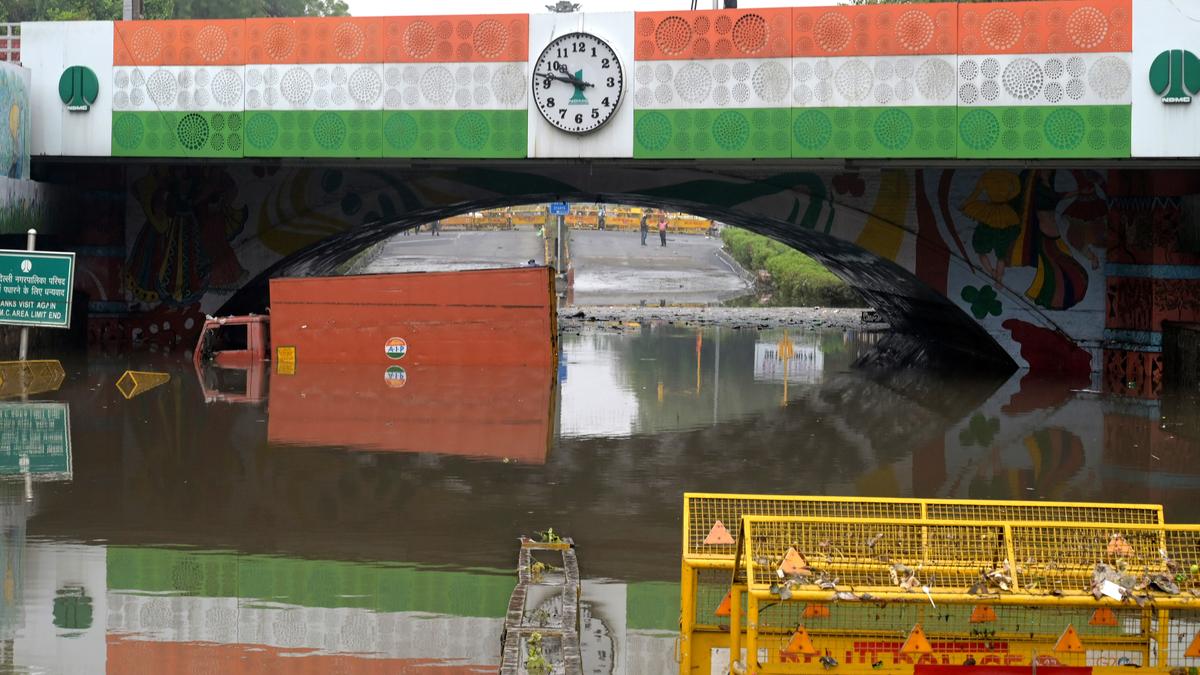The Minto Bridge was water-logged after heavy rain in New Delhi on June 28, 2024.
| Photo Credit: R.V. Moorthy
The monsoon arrived in Delhi on June 28, with rains causing devastation across the city. A three-hour downpour led to the roof of Delhi Airport’s Terminal-1 collapsing, killing one person and flight operations were affected.
The Safdarjung Observatory, the city’s primary weather station, recorded 228.1 mm of rainfall in the 24 hours ending at 8:30 a.m. on June 28, more than three times the June rainfall average of 74.1 mm and the highest for the month in 88 years — since 1936.
Delhi airport terminal roof collapse
The India Meteorological Department (IMD), which defines very heavy rain as rainfall amounting to between 124.5 and 244.4 mm in a day, said later in the morning that the monsoon has arrived. The downpour began around 3 am.
The early morning rain, which brought India’s national capital to its knees, claimed at least one more life with a 39-year-old man electrocuted in Rohini. Three labourers were trapped when an under-construction wall in Vasant Vihar collapsed early in the morning and rescue operations continued till evening, their hopes of survival dimming with each passing minute.

Delhiites woke up to water entering homes, submerging vehicles and leading to miles-long traffic snarls that took hours to detangle. Thousands of commuters were stranded as tunnels, including the one at Pragati Maidan, were closed. Reports of homes being flooded came in from across the city, including upscale areas of Lutyens Delhi, Hauz Khas, South Extension and Mayur Vihar on the first day of heavy rain.
One dead as roof, support beams collapse in New Delhi Airport
The destruction took a tragic turn at the Delhi Airport’s busy Terminal 1. Around 5 a.m., a massive canopy covering the departure area gave way, trapping several people. Besides the roof sheet, support beams collapsed, pinning down parked cars.

A taxi driver, identified as Ramesh Kumar, was rescued from a car on which an iron beam had fallen but was declared dead when he was taken to the Medanta Hospital facility near the terminal. The injured were admitted to the hospital “… flights to & from Terminal 1 have been closed till further notice. Alternate arrangements are being made for the smooth operation of the flights,” the Civil Aviation ministry said in a post on X.
Delhi airport operator DIAL, which set up a technical committee to probe the roof collapse, said in a statement, “While the cause for the collapse is being assessed, the primary cause seems to be the continued heavy rainfall over the past few hours.”
T1 has only domestic flight operations by IndiGo and SpiceJet. The airport, which has three terminals T1, T2 and T3, handles around 1,400 flight movements daily.
An IndiGo spokesperson said the unplanned situation has led to operations across the network being impacted. In a post on X, SpiceJet said flights were cancelled as T1 will remain partially closed for operations until further notice.
A case under Section 337 (causing hurt by act endangering life or personal safety of others) and 304A (causing death by negligence) was registered against unknown persons in tragedy, Delhi Police officials said.
Delhi government’s emergency meeting
A rickshaw puller makes his way out through a water-logged road in New Delhi on June 28, 2024.
| Photo Credit:
SHASHI SHEKHAR KASHYAP
The Delhi government called an emergency meeting in the afternoon to take stock of the situation. “It was after 1936 that Delhi received 228 mm of rainfall in 24 hours. It means, that out of total monsoon rainfall (800 mm) in Delhi, 25% rain occurred in just 24 hours. Due to this reason, drain overflow happened in several areas and it took time for the water to drain out,” said AAP minister Atishi.
Chairing an emergency meeting, Lt. Governor V.K. Saxena also took stock of the situation and directed officials to set up an emergency control room and deploy static pumps to address waterlogging reports. Mr. Saxena noted that the de-silting of drains had not been completed and the Flood Control Order was yet to be issued. He asked officials to undertake the de-silting work on an emergent basis over the next week, the LG’s office said.
Power outages were reported at many locations, including Dwarka and Jangpura. In many residential areas, locals were seen wading through waist-deep water.

